Service Platform for Integration of various M2M/IoT system
The number of M2M devices is dramatically increasing and expected to reach to 20.0 billion in 2020.
But at present, especially in industries, most M2M solutions provide customers with proprietary systems,
which involve all layers, from application layer to
physical layer, and specialized services. That results in
limitations in the system extension supporting new services integrating different technologies and the interoperability of various M2M systems. It also makes
difficulties in scalability, flexibility, and fault tolerance. Therefore, there is a strong demand to establish
a common M2M service platform from various standard organizations. oneM2M is one of solution for such
platform, which is expected to bridge the gap between
individual technology and the platform.
In this article, we aim to provide an oneM2M
structure implementation that demonstrates the interconnection of various IoT applications based on three
protocols in the application layer (HTTP, CoAP,
MQTT) and diversified wireless technologies (Wi-Fi,
Bluetooth, Zigbee). Therefore, data can be transmitted
without regarding to the physical layer or the difference in their upper transmission protocols. The composition of this paper is as follows. Section 2 introduces details of the oneM2M standard and these transmission protocols, technologies will be implemented.
We describe an architecture to interpret the operation
of the systems in section 3 and discuss about the capacity to expanding follow edge computing orientation
in section 4. The conclusion is present in section 5.
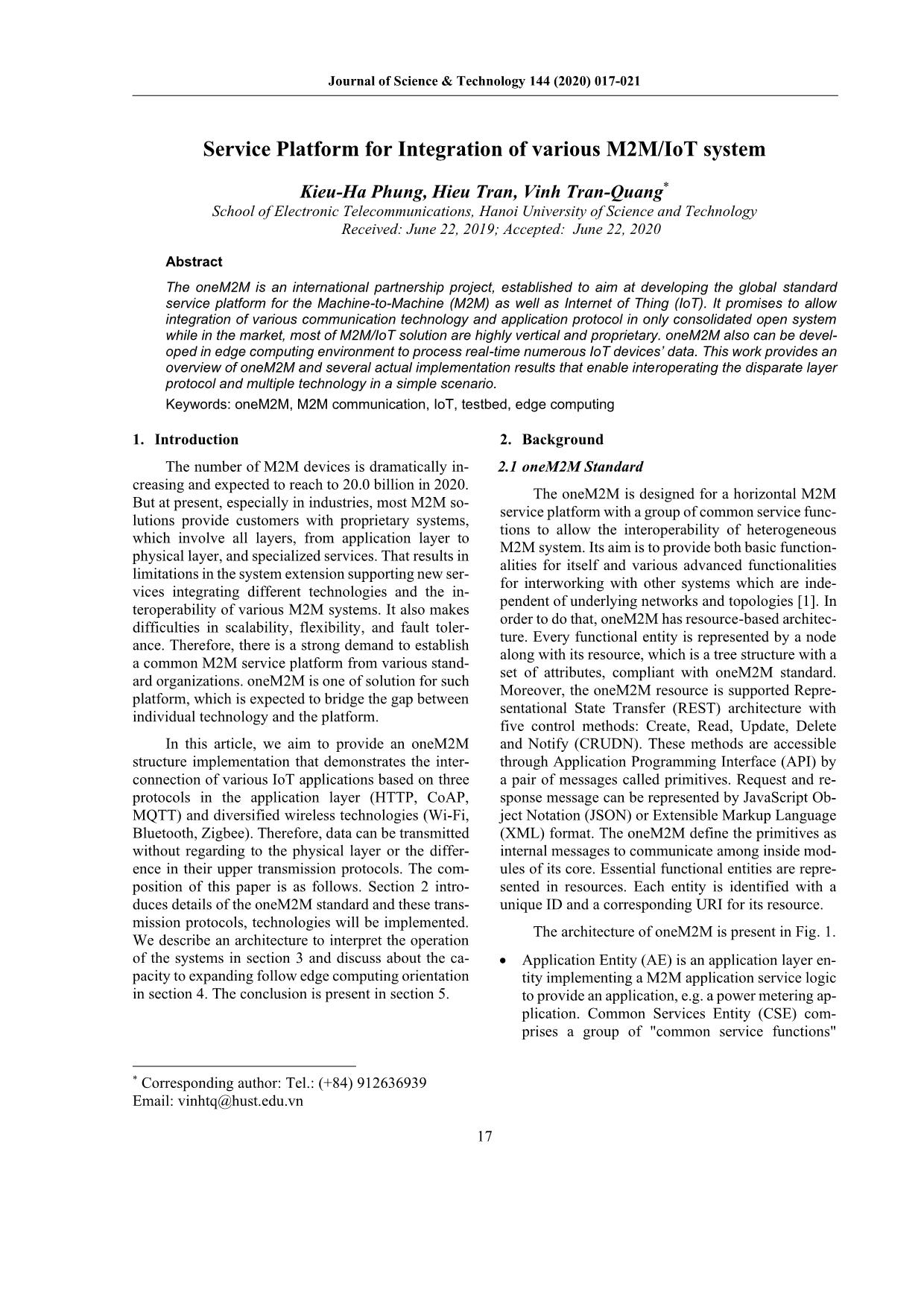
Trang 1
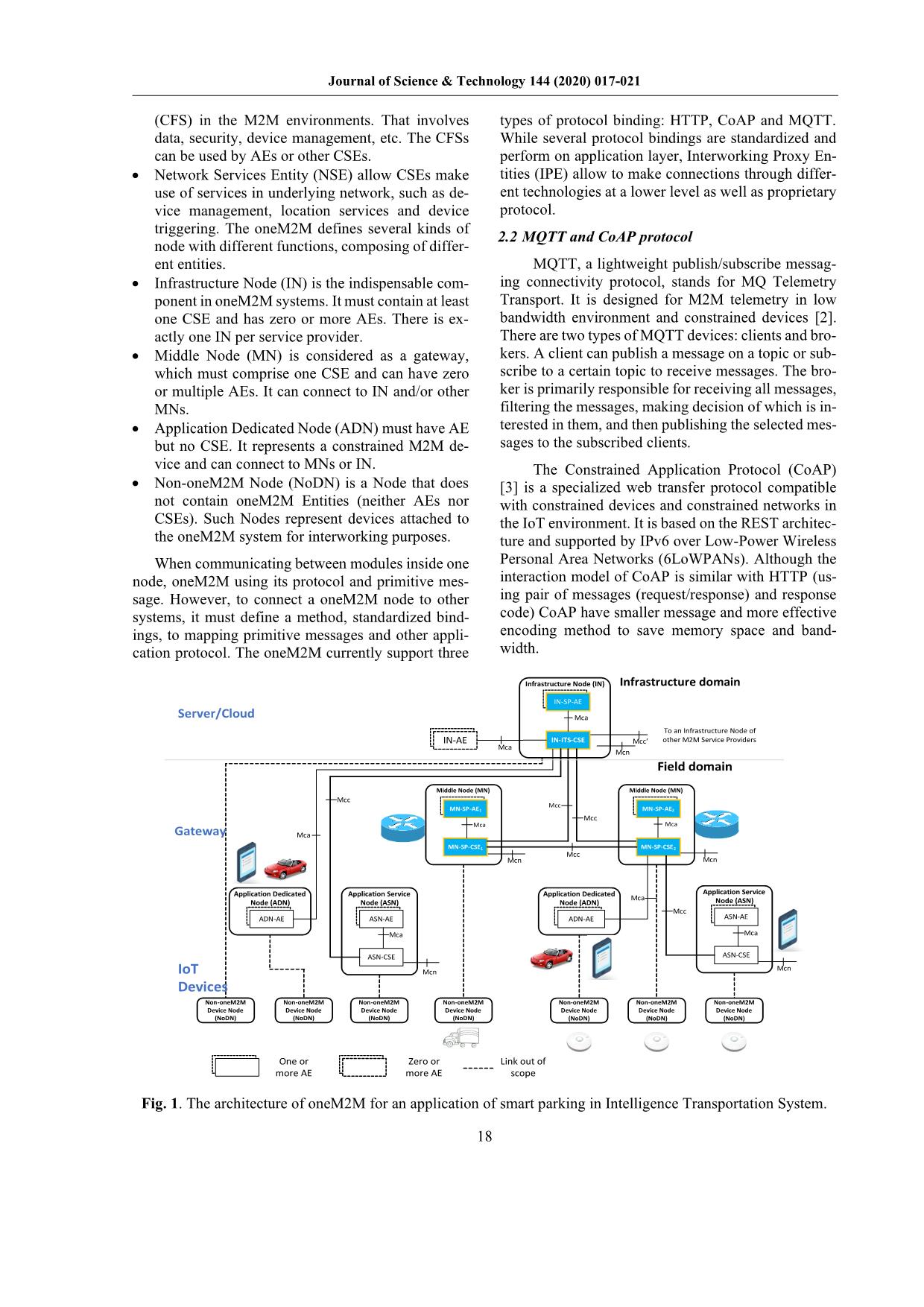
Trang 2
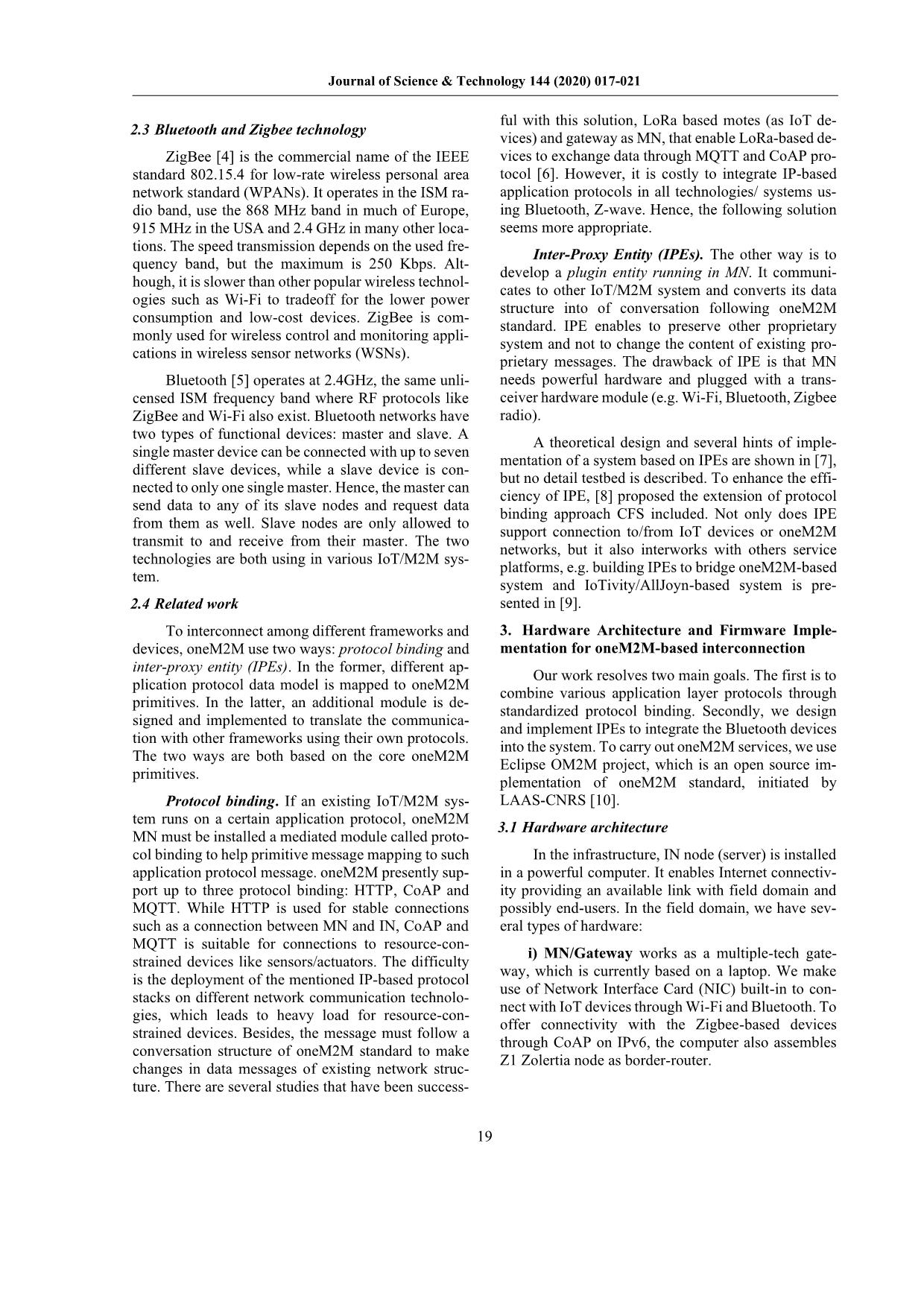
Trang 3
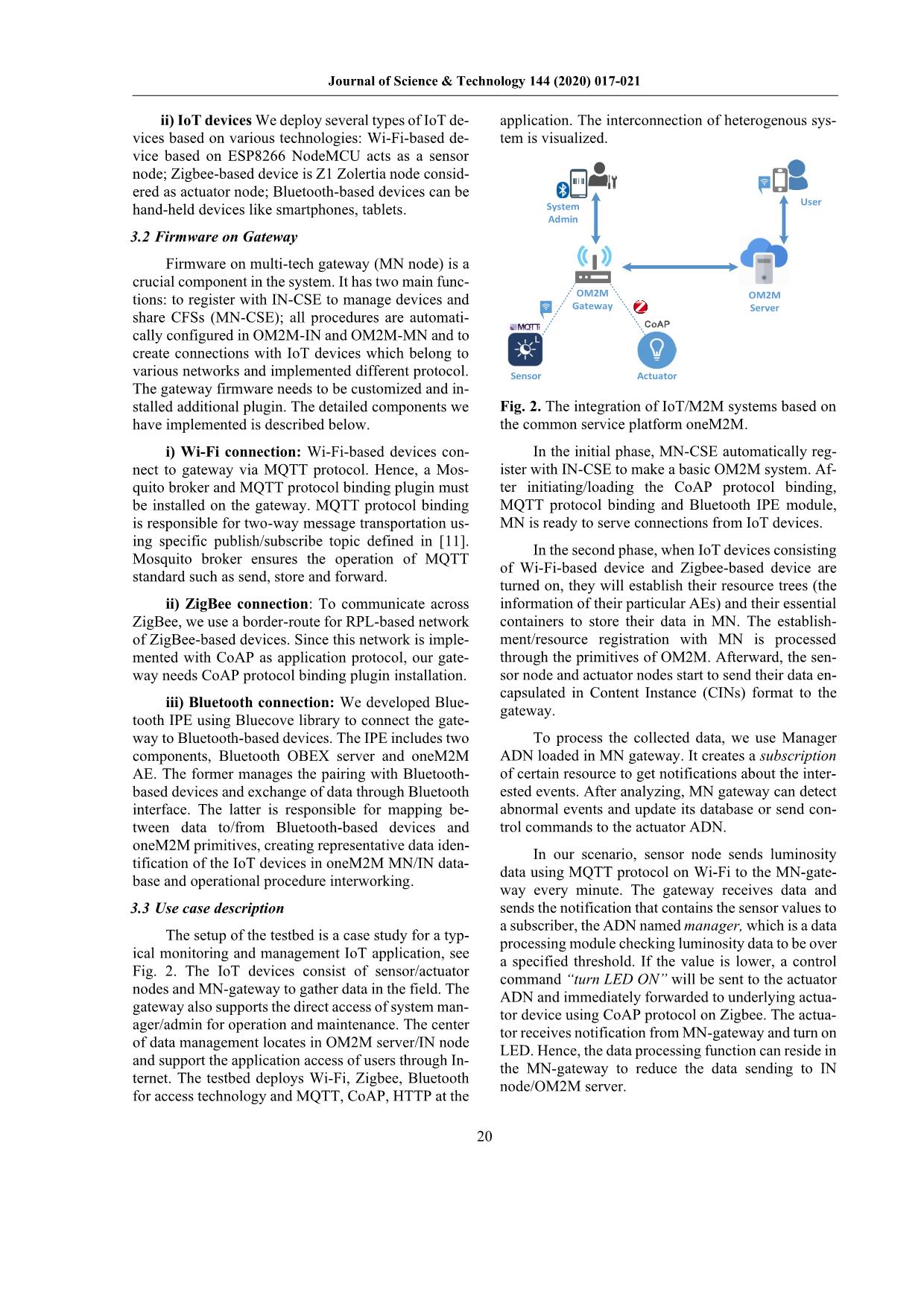
Trang 4
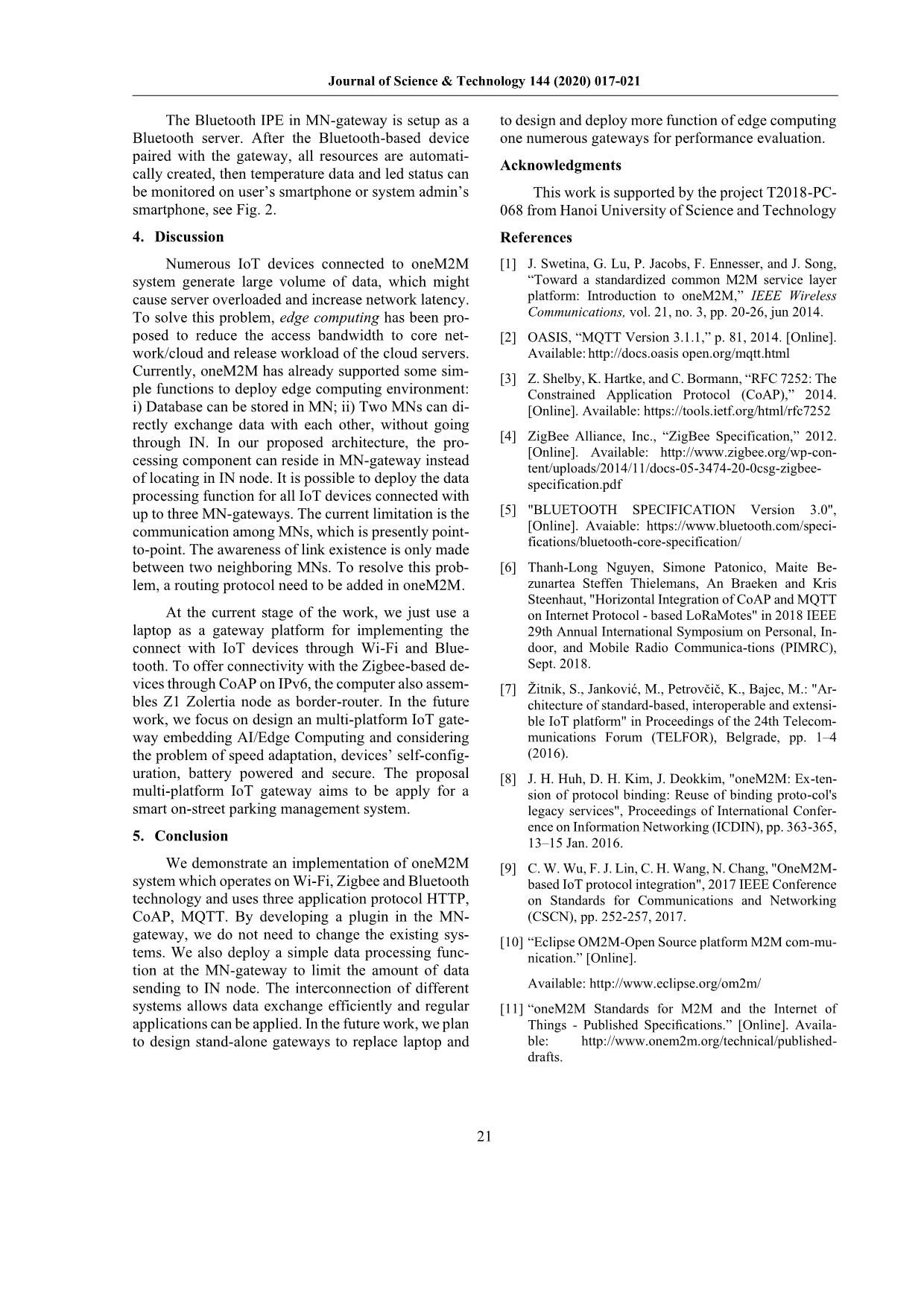
Trang 5
Tóm tắt nội dung tài liệu: Service Platform for Integration of various M2M/IoT system
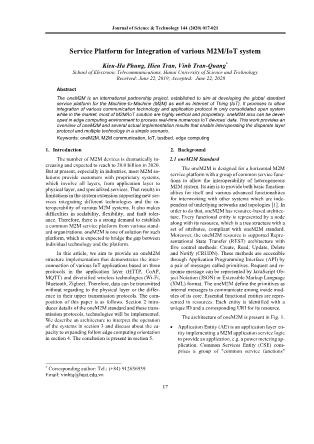
ASN-AE Mca Mcn Non-oneM2M Device Node (NoDN) Mcc Mcc Mcc Mcc Mcc Mcc Mca Mca Mca Infrastructure domain To an Infrastructure Node of other M2M Service Providers Field domain One or more AE Zero or more AE Link out of scope Server/Cloud Gateway IoT Devices Journal of Science & Technology 144 (2020) 017-021 19 2.3 Bluetooth and Zigbee technology ZigBee [4] is the commercial name of the IEEE standard 802.15.4 for low-rate wireless personal area network standard (WPANs). It operates in the ISM ra- dio band, use the 868 MHz band in much of Europe, 915 MHz in the USA and 2.4 GHz in many other loca- tions. The speed transmission depends on the used fre- quency band, but the maximum is 250 Kbps. Alt- hough, it is slower than other popular wireless technol- ogies such as Wi-Fi to tradeoff for the lower power consumption and low-cost devices. ZigBee is com- monly used for wireless control and monitoring appli- cations in wireless sensor networks (WSNs). Bluetooth [5] operates at 2.4GHz, the same unli- censed ISM frequency band where RF protocols like ZigBee and Wi-Fi also exist. Bluetooth networks have two types of functional devices: master and slave. A single master device can be connected with up to seven different slave devices, while a slave device is con- nected to only one single master. Hence, the master can send data to any of its slave nodes and request data from them as well. Slave nodes are only allowed to transmit to and receive from their master. The two technologies are both using in various IoT/M2M sys- tem. 2.4 Related work To interconnect among different frameworks and devices, oneM2M use two ways: protocol binding and inter-proxy entity (IPEs). In the former, different ap- plication protocol data model is mapped to oneM2M primitives. In the latter, an additional module is de- signed and implemented to translate the communica- tion with other frameworks using their own protocols. The two ways are both based on the core oneM2M primitives. Protocol binding. If an existing IoT/M2M sys- tem runs on a certain application protocol, oneM2M MN must be installed a mediated module called proto- col binding to help primitive message mapping to such application protocol message. oneM2M presently sup- port up to three protocol binding: HTTP, CoAP and MQTT. While HTTP is used for stable connections such as a connection between MN and IN, CoAP and MQTT is suitable for connections to resource-con- strained devices like sensors/actuators. The difficulty is the deployment of the mentioned IP-based protocol stacks on different network communication technolo- gies, which leads to heavy load for resource-con- strained devices. Besides, the message must follow a conversation structure of oneM2M standard to make changes in data messages of existing network struc- ture. There are several studies that have been success- ful with this solution, LoRa based motes (as IoT de- vices) and gateway as MN, that enable LoRa-based de- vices to exchange data through MQTT and CoAP pro- tocol [6]. However, it is costly to integrate IP-based application protocols in all technologies/ systems us- ing Bluetooth, Z-wave. Hence, the following solution seems more appropriate. Inter-Proxy Entity (IPEs). The other way is to develop a plugin entity running in MN. It communi- cates to other IoT/M2M system and converts its data structure into of conversation following oneM2M standard. IPE enables to preserve other proprietary system and not to change the content of existing pro- prietary messages. The drawback of IPE is that MN needs powerful hardware and plugged with a trans- ceiver hardware module (e.g. Wi-Fi, Bluetooth, Zigbee radio). A theoretical design and several hints of imple- mentation of a system based on IPEs are shown in [7], but no detail testbed is described. To enhance the effi- ciency of IPE, [8] proposed the extension of protocol binding approach CFS included. Not only does IPE support connection to/from IoT devices or oneM2M networks, but it also interworks with others service platforms, e.g. building IPEs to bridge oneM2M-based system and IoTivity/AllJoyn-based system is pre- sented in [9]. 3. Hardware Architecture and Firmware Imple- mentation for oneM2M-based interconnection Our work resolves two main goals. The first is to combine various application layer protocols through standardized protocol binding. Secondly, we design and implement IPEs to integrate the Bluetooth devices into the system. To carry out oneM2M services, we use Eclipse OM2M project, which is an open source im- plementation of oneM2M standard, initiated by LAAS-CNRS [10]. 3.1 Hardware architecture In the infrastructure, IN node (server) is installed in a powerful computer. It enables Internet connectiv- ity providing an available link with field domain and possibly end-users. In the field domain, we have sev- eral types of hardware: i) MN/Gateway works as a multiple-tech gate- way, which is currently based on a laptop. We make use of Network Interface Card (NIC) built-in to con- nect with IoT devices through Wi-Fi and Bluetooth. To offer connectivity with the Zigbee-based devices through CoAP on IPv6, the computer also assembles Z1 Zolertia node as border-router. Journal of Science & Technology 144 (2020) 017-021 20 ii) IoT devices We deploy several types of IoT de- vices based on various technologies: Wi-Fi-based de- vice based on ESP8266 NodeMCU acts as a sensor node; Zigbee-based device is Z1 Zolertia node consid- ered as actuator node; Bluetooth-based devices can be hand-held devices like smartphones, tablets. 3.2 Firmware on Gateway Firmware on multi-tech gateway (MN node) is a crucial component in the system. It has two main func- tions: to register with IN-CSE to manage devices and share CFSs (MN-CSE); all procedures are automati- cally configured in OM2M-IN and OM2M-MN and to create connections with IoT devices which belong to various networks and implemented different protocol. The gateway firmware needs to be customized and in- stalled additional plugin. The detailed components we have implemented is described below. i) Wi-Fi connection: Wi-Fi-based devices con- nect to gateway via MQTT protocol. Hence, a Mos- quito broker and MQTT protocol binding plugin must be installed on the gateway. MQTT protocol binding is responsible for two-way message transportation us- ing specific publish/subscribe topic defined in [11]. Mosquito broker ensures the operation of MQTT standard such as send, store and forward. ii) ZigBee connection: To communicate across ZigBee, we use a border-route for RPL-based network of ZigBee-based devices. Since this network is imple- mented with CoAP as application protocol, our gate- way needs CoAP protocol binding plugin installation. iii) Bluetooth connection: We developed Blue- tooth IPE using Bluecove library to connect the gate- way to Bluetooth-based devices. The IPE includes two components, Bluetooth OBEX server and oneM2M AE. The former manages the pairing with Bluetooth- based devices and exchange of data through Bluetooth interface. The latter is responsible for mapping be- tween data to/from Bluetooth-based devices and oneM2M primitives, creating representative data iden- tification of the IoT devices in oneM2M MN/IN data- base and operational procedure interworking. 3.3 Use case description The setup of the testbed is a case study for a typ- ical monitoring and management IoT application, see Fig. 2. The IoT devices consist of sensor/actuator nodes and MN-gateway to gather data in the field. The gateway also supports the direct access of system man- ager/admin for operation and maintenance. The center of data management locates in OM2M server/IN node and support the application access of users through In- ternet. The testbed deploys Wi-Fi, Zigbee, Bluetooth for access technology and MQTT, CoAP, HTTP at the application. The interconnection of heterogenous sys- tem is visualized. Fig. 2. The integration of IoT/M2M systems based on the common service platform oneM2M. In the initial phase, MN-CSE automatically reg- ister with IN-CSE to make a basic OM2M system. Af- ter initiating/loading the CoAP protocol binding, MQTT protocol binding and Bluetooth IPE module, MN is ready to serve connections from IoT devices. In the second phase, when IoT devices consisting of Wi-Fi-based device and Zigbee-based device are turned on, they will establish their resource trees (the information of their particular AEs) and their essential containers to store their data in MN. The establish- ment/resource registration with MN is processed through the primitives of OM2M. Afterward, the sen- sor node and actuator nodes start to send their data en- capsulated in Content Instance (CINs) format to the gateway. To process the collected data, we use Manager ADN loaded in MN gateway. It creates a subscription of certain resource to get notifications about the inter- ested events. After analyzing, MN gateway can detect abnormal events and update its database or send con- trol commands to the actuator ADN. In our scenario, sensor node sends luminosity data using MQTT protocol on Wi-Fi to the MN-gate- way every minute. The gateway receives data and sends the notification that contains the sensor values to a subscriber, the ADN named manager, which is a data processing module checking luminosity data to be over a specified threshold. If the value is lower, a control command “turn LED ON” will be sent to the actuator ADN and immediately forwarded to underlying actua- tor device using CoAP protocol on Zigbee. The actua- tor receives notification from MN-gateway and turn on LED. Hence, the data processing function can reside in the MN-gateway to reduce the data sending to IN node/OM2M server. OM2M Gateway OM2M Server UserSystem Admin Sensor Actuator Journal of Science & Technology 144 (2020) 017-021 21 The Bluetooth IPE in MN-gateway is setup as a Bluetooth server. After the Bluetooth-based device paired with the gateway, all resources are automati- cally created, then temperature data and led status can be monitored on user’s smartphone or system admin’s smartphone, see Fig. 2. 4. Discussion Numerous IoT devices connected to oneM2M system generate large volume of data, which might cause server overloaded and increase network latency. To solve this problem, edge computing has been pro- posed to reduce the access bandwidth to core net- work/cloud and release workload of the cloud servers. Currently, oneM2M has already supported some sim- ple functions to deploy edge computing environment: i) Database can be stored in MN; ii) Two MNs can di- rectly exchange data with each other, without going through IN. In our proposed architecture, the pro- cessing component can reside in MN-gateway instead of locating in IN node. It is possible to deploy the data processing function for all IoT devices connected with up to three MN-gateways. The current limitation is the communication among MNs, which is presently point- to-point. The awareness of link existence is only made between two neighboring MNs. To resolve this prob- lem, a routing protocol need to be added in oneM2M. At the current stage of the work, we just use a laptop as a gateway platform for implementing the connect with IoT devices through Wi-Fi and Blue- tooth. To offer connectivity with the Zigbee-based de- vices through CoAP on IPv6, the computer also assem- bles Z1 Zolertia node as border-router. In the future work, we focus on design an multi-platform IoT gate- way embedding AI/Edge Computing and considering the problem of speed adaptation, devices’ self-config- uration, battery powered and secure. The proposal multi-platform IoT gateway aims to be apply for a smart on-street parking management system. 5. Conclusion We demonstrate an implementation of oneM2M system which operates on Wi-Fi, Zigbee and Bluetooth technology and uses three application protocol HTTP, CoAP, MQTT. By developing a plugin in the MN- gateway, we do not need to change the existing sys- tems. We also deploy a simple data processing func- tion at the MN-gateway to limit the amount of data sending to IN node. The interconnection of different systems allows data exchange efficiently and regular applications can be applied. In the future work, we plan to design stand-alone gateways to replace laptop and to design and deploy more function of edge computing one numerous gateways for performance evaluation. Acknowledgments This work is supported by the project T2018-PC- 068 from Hanoi University of Science and Technology References [1] J. Swetina, G. Lu, P. Jacobs, F. Ennesser, and J. Song, “Toward a standardized common M2M service layer platform: Introduction to oneM2M,” IEEE Wireless Communications, vol. 21, no. 3, pp. 20-26, jun 2014. [2] OASIS, “MQTT Version 3.1.1,” p. 81, 2014. [Online]. Available: open.org/mqtt.html [3] Z. Shelby, K. Hartke, and C. Bormann, “RFC 7252: The Constrained Application Protocol (CoAP),” 2014. [Online]. Available: https://tools.ietf.org/html/rfc7252 [4] ZigBee Alliance, Inc., “ZigBee Specification,” 2012. [Online]. Available: tent/uploads/2014/11/docs-05-3474-20-0csg-zigbee- specification.pdf [5] "BLUETOOTH SPECIFICATION Version 3.0", [Online]. Avaiable: https://www.bluetooth.com/speci- fications/bluetooth-core-specification/ [6] Thanh-Long Nguyen, Simone Patonico, Maite Be- zunartea Steffen Thielemans, An Braeken and Kris Steenhaut, "Horizontal Integration of CoAP and MQTT on Internet Protocol - based LoRaMotes" in 2018 IEEE 29th Annual International Symposium on Personal, In- door, and Mobile Radio Communica-tions (PIMRC), Sept. 2018. [7] Žitnik, S., Janković, M., Petrovčič, K., Bajec, M.: "Ar- chitecture of standard-based, interoperable and extensi- ble IoT platform" in Proceedings of the 24th Telecom- munications Forum (TELFOR), Belgrade, pp. 1–4 (2016). [8] J. H. Huh, D. H. Kim, J. Deokkim, "oneM2M: Ex-ten- sion of protocol binding: Reuse of binding proto-col's legacy services", Proceedings of International Confer- ence on Information Networking (ICDIN), pp. 363-365, 13–15 Jan. 2016. [9] C. W. Wu, F. J. Lin, C. H. Wang, N. Chang, "OneM2M- based IoT protocol integration", 2017 IEEE Conference on Standards for Communications and Networking (CSCN), pp. 252-257, 2017. [10] “Eclipse OM2M-Open Source platform M2M com-mu- nication.” [Online]. Available: [11] “oneM2M Standards for M2M and the Internet of Things - Published Specifications.” [Online]. Availa- ble: drafts.
File đính kèm:
 service_platform_for_integration_of_various_m2miot_system.pdf
service_platform_for_integration_of_various_m2miot_system.pdf

